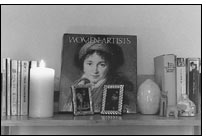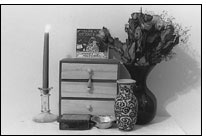When a woman creates an altar, she re-collects the scattered parts of herself, reconnects with her inner beauty, and reflects on the Essential Feminine within her psyche.
 Her altar represents her essential self and becomes a visual metaphor for her woman-spirit. A woman's altar is the bridge between her inner world and the world of form. It is where she is free to capture and display the shapes, the shades, and the substance of her invisible essence. Once she has created the altar, a woman depends on it to tell the story of her inner life. It is a place of her own where she can take time to make sense of the insane pace of her life, where she can find the space to simplify, where she can just sit and stare.
Her altar represents her essential self and becomes a visual metaphor for her woman-spirit. A woman's altar is the bridge between her inner world and the world of form. It is where she is free to capture and display the shapes, the shades, and the substance of her invisible essence. Once she has created the altar, a woman depends on it to tell the story of her inner life. It is a place of her own where she can take time to make sense of the insane pace of her life, where she can find the space to simplify, where she can just sit and stare.
The altar becomes a place where the woman can commune with both the personal and the cosmic aspects of herself, where she can both dance with the Divine and imbue every aspect of her personal life with sacredness, where she can both reclaim her power and revel in her innate beauty.
An altar can be used in many ways:
to say thank you to the powers that be
to celebrate Mother Nature in all her guises
to seek spiritual wisdom
to honor the ancestors
to offer up struggles
to receive creative inspiration
to dialogue with the deeper part of her being
to honor her body
This is a partial list--the uses of the altar are limited only by a woman's imagination!
The altar is a canvas on which a woman paints various and often contradictory portraits of herself: One month she's in touch with her artist's soul, the next she's considering taking courses in computer science. One week she's intent on mediating her family's problems, the next she's boldly, bluntly expressing her opinions to all concerned. One day she's all gentle warmth, the next she's a sizzling siren. The various altars reflect and honor all the many selves she harbors within her psyche.
Creating an altar is a life-affirming act in a world seemingly hell-bent on destruction. The altar provides comfort by acclaiming, through its very existence, that the woman is an integral part of the living cosmos, that her life is touched by the same mysterious rhythm bringing the seasons round and round, and that beneath the apparent chaos of her life an ordering force beats quietly. The altar becomes an exquisite manifestation of the healing energy of integration. Altar-making clears a path through the clutter of her world and creates a place where the feminine force in her life is visible, where she is free to maker her inner journey, where healing is abundant.
If you are unsure where to begin, set aside some "quiet time" and contemplate the following thought-provoking questions:
"What am I thankful for?"
"What gives me peace?"
"What healing or blessing do I need?"
"What inspires me?"
"What is magical in my life?"
"What makes me feel special?"
"What in my life excites me, gets my juices flowing, makes me feel alive?"
Jot down your answers. The questions focus you on both the difficulties and the blessings in your life. The answers fecome the fertile soil from which springs the themes for your personal altars.
[Here are] several possible themes for your altar:
Honor Mother Nature
Connect with the energy of wind, fire, earth, or water
Pay homage to a totem animal or a deceased pet
Gather healing energies for yourself or another
Offer thanks
Prepare for a difficult task
Bring good luck
Connect with the muse of creativity
Gather your dreams
Pay homage to the holiness of daily life
Any of these--or one of your own--is a perfect altar theme.
 You instinctively pick it up and turn it over in your hand. The feather begins a flow of thought. The color reminds you of a startling blue place mat tucked away in the linen drawer. You remember a gorgeous picture of a bird in flight from a nature magazine. The bird was photographed against a dawn sky just before sunrise. You become aware that yellow candles will mimic the sun's glow and accent the yellows in the picture. Before you realize it, you've found the theme, the colors, the centerpiece--all inspired by a blue jay's feather, which you now lay in a place of honor in the center of your altar.
You instinctively pick it up and turn it over in your hand. The feather begins a flow of thought. The color reminds you of a startling blue place mat tucked away in the linen drawer. You remember a gorgeous picture of a bird in flight from a nature magazine. The bird was photographed against a dawn sky just before sunrise. You become aware that yellow candles will mimic the sun's glow and accent the yellows in the picture. Before you realize it, you've found the theme, the colors, the centerpiece--all inspired by a blue jay's feather, which you now lay in a place of honor in the center of your altar.Once you choose the intention for your altar, select a place where you can set it up. Remember, an altar can be created anywhere, outdoors or indoors. Once you make a place special through the creation of an altar, you begin to respond to that place with a certain reverence. The altar absorbs and retains some of this reverential energy and so, over time, you become aware of the interplay of energy between you, the altar-maker, and your creation, the altar.
You have a theme and you've chosen a place. The question is now, "What do you place on your altar?" The answer is, "Anything you please!" An altar is a place where you give attention to objects and people and places that matter to you. When choosing objects for your altar, select those that revolve around your theme.
If you find inspiration in nature, consider which of the four elements you feel the most affinity towards an dedicate your altar to that element. Choose flags, fans, or bird feathers to represent air, and bowls of spring water, seashells, wine, or essence oils to symbolize water. Gems, stones, crystals, potting soil, plants, and flowers for earth; candles, incense, pictures of flames or drawings of the sun for fire. Any or all of the four elements can be represented on your nature altar, whether it be indoors or out. If you wish to represent all four elements on your indoor nature altar, you might include a candle for fire, a paper fan to air, flowers for earth, and a bowl of water.
Perhaps your theme centers on your desire to spend more time at the ocean. To mirror this need, choose objects that reflect your love of the sea: a watercolor of the ocean, a bowl of beach sand, a dried starfish, and a snapshot of you frolicking in the ocean. These visual representations of your desire to visit the ocean will help you focus on that desire when you sit before your ocean altar.
The beach is the perfect setting for a temporary outdoor altar. Simply take a pail, fill it with sand, place a circle of sea-washed beach stones on the sand, and stick a seagull feather into the center of the circle. In this way you have created a space apart which honors sky (feathers), sea (beach stones), and earth (sand).
Consider creating an altar to pay tribute to the private self hidden deep within the psyche. For this type of altar choose objects that symbolize disparate parts of your inner self. An altar honoring your many selves emanates a wild beauty, a terrible truth, an awesome power. The altar becomes a stage upon which the inner and outer selves merge, creating a wholeness that is truly healing.
Relax and trust the altar-making process. Know that various objects such as scarves for altar clothes, statues, pictures, candles, and candleholders will find their way to you. Objects you find around the house, in the yard, or in the shed will suddenly appear in a different light as you become more in tune with the art of altar creation. Altar objects are sacred because you consider them special--that is the only criterion.

